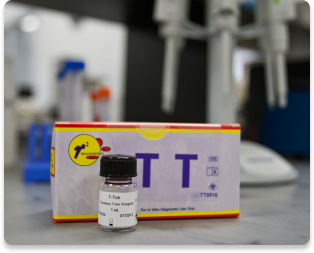T-Tek
Assay Type
Description
Intended Use
Uses
- To rule out the presence of heparin (in conjunction with the Reptilase Time)
- To detect qualitative abnormalities or quantitative deficiencies of fibrinogen

Ordering Information
| Catalog # | Product | Kit Configuration | Regulatory Classification | Product Insert (PDF) |
|---|---|---|---|---|
| 50-201 | T-Tek | 10 x 1 mL | 510(k), CE | LL-4517_E TTek |
Principle of the Test
The active coagulation enzyme, thrombin, acts on soluble fibrinogen to convert it to insoluble fibrin. This reaction is manifested by the appearance of a visible fibrin clot. Any substance that interferes with this reaction, i.e. heparin or fibrin degradation products, may produce a prolonged thrombin clotting time. Low plasma fibrinogen levels as well as abnormal fibrinogen molecules seen in severe liver disease or as congenital abnormalities will also prolong the clotting time.
The Thrombin Time test is performed by adding 1 volume of Thrombin Time reagent to 1 volume of citrated plasma pre-warmed to 37C, and the time taken to detect the clot end point is recorded.
Reporting Units
Handbooks and Guidelines
- Thrombin Time Assays, pages 219-220, in Lapasota et. al., The Clinical Hemostasis Handbook, Year Book Medical Publishers, 1989. This handbook is no longer in print, but many pathologists have a copy.
- Rogers G, Chapter 5 “Hemostasis Screening Assays”, in Laboratory Hemostasis: A Practical Guide for Pathologists, Bennet S et. al. editors, Springer 2007.
- Krishnan J, Chapter 6, “Coagulation Testing”, in An Algorithmic Approach to Hemostasis Testing, Kottke‑Marchant ed., CAP Press, 2008.
